Simulation of Water Balance Components Using SWAT Model at Sub Catchment Level
Abstract
:1. Introduction
- Developing semi distributed monthly water balance model over a catchment in south India in SWAT. Model provides the spatial and temporal distribution of WBCs viz. AE, surface runoff, lateral flow, SW and percolation over a catchment.
- To evaluate the applicability and suitability, the developed model was calibrated and validated over using measured gauge discharge. Additionally, the model performance was verified with gridded global AE.
- The calibrated model is used for spatiotemporal mapping of WBCs over the sub catchments by forcing the prevailing LULC and meteorological conditions.
2. Materials and Methods
2.1. Study Area
2.2. Hydrological Response Unit
2.3. Topography
2.4. Land Use and Land Cover
2.5. Soil Data
2.6. Meteorological Parameters
2.7. Model Calibration and Validation
3. Results and Discussions
3.1. Calibration and Validation
3.2. Water Balance Components
4. Conclusions
- The residential land area doubled between 2001 and 2011, indicating frenzied construction activity over the catchment. The annual average reduction of water bodies over the catchment is about 1 sq. km/year. The increase in residential land and mutual changes among the other classes leads to an increase in surface runoff and reduction in lateral flow and percolation.
- Out of the four simulated WBCs, surface runoff and AE show maximum variations at monthly scale at all sub catchment. The lateral flow and percolation shown least variation. Developing appropriate rain water harvesting and artificial groundwater recharge infrastructures helps to reduce flood, soil erosion and drought over catchment.
- Relative sensitivity analysis depicted that CN2 gives highly sensitive parameter followed by GW_DELAY and ALPHA_BNK over the catchment.
- Generally, SW was more than 50 mm (i.e., above 12% SW) from October to March at all sub catchment. Hence the famers over the Chittar catchment may prefer to raise single crop.
- The SW in the upstream sub catchments SC2, SC3 and SC8 were low throughout the simulation period. This may contribute to increase the frequency and intensity of agricultural drought over the sub catchment.
- The average monthly percolation of SC1, SC2, SC5 and SC8 were more than 10 mm. The higher percolation increases natural groundwater recharge and leaching in soil.
- The mountains forested environment in SC3 increases the lateral flow that subsequently reduces surface runoff, ET and SW. The high lateral flow enhance transport soil and its nutrient in to water bodies.
Author Contributions
Funding
Data Availability Statement
Acknowledgments
Conflicts of Interest
References
- Mishra, A.K.; Singh, V.P. A Review of Drought Concepts. J. Hydrol. 2010, 391, 202–216. [Google Scholar] [CrossRef]
- Llasat, M.C.; Llasat-Botija, M.; Barnolas, M.; Ĺopez, L.; Altava-Ortiz, V. An Analysis of the Evolution of Hydrometeorological Extremes in Newspapers: The Case of Catalonia, 1982–2006. Nat. Hazards Earth Syst. Sci. 2009, 9, 1201–1212. [Google Scholar] [CrossRef] [Green Version]
- Oeurng, C.; Sauvage, S.; Sánchez-Pérez, J.M. Assessment of Hydrology, Sediment and Particulate Organic Carbon Yield in a Large Agricultural Catchment Using the SWAT Model. J. Hydrol. 2011, 401, 145–153. [Google Scholar] [CrossRef] [Green Version]
- Dickinson, R.E. Land Processes in Climate Models. Remote Sens. Environ. 1995, 51, 27–38. [Google Scholar] [CrossRef]
- Liang, X.; Xie, Z. Important Factors in Land-Atmosphere Interactions: Surface Runoff Generations and Interactions between Surface and Groundwater. Glob. Planet. Change 2003, 38, 101–114. [Google Scholar] [CrossRef]
- Strasser, U.; Mauser, W. Modelling the Spatial and Temporal Variations of the Water Balance for the Weser Catchment 1965–1994. J. Hydrol. 2001, 254, 199–214. [Google Scholar] [CrossRef]
- Yang, D.; Sun, F.; Liu, Z.; Cong, Z.; Ni, G.; Lei, Z. Analyzing Spatial and Temporal Variability of Annual Water-Energy Balance in Nonhumid Regions of China Using the Budyko Hypothesis. Water Resour. Res. 2007, 43, W04426. [Google Scholar] [CrossRef]
- Chang, H.; Jung, I.W. Spatial and Temporal Changes in Runoff Caused by Climate Change in a Complex Large River Basin in Oregon. J. Hydrol. 2010, 388, 186–207. [Google Scholar] [CrossRef]
- Kundu, S.; Khare, D.; Mondal, A. Past, Present and Future Land Use Changes and Their Impact on Water Balance. J. Environ. Manag. 2017, 197, 582–596. [Google Scholar] [CrossRef]
- Graf, R.; Jawgiel, K. The Impact of the Parameterisation of Physiographic Features of Urbanised Catchment Areas on the Spatial Distribution of Components of the Water Balance Using the WetSpass Model. ISPRS Int. J. Geo-Inf. 2018, 7, 278. [Google Scholar] [CrossRef]
- Amin, A.; Iqbal, J.; Asghar, A.; Ribbe, L. Analysis of Current and Futurewater Demands in the Upper Indus Basin under IPCC Climate and Socio-Economic Scenarios Using a Hydro-Economic WEAP Model. Water 2018, 10, 537. [Google Scholar] [CrossRef] [Green Version]
- Li, S.; Yang, H.; Lacayo, M.; Liu, J.; Lei, G. Impacts of Land-Use and Land-Cover Changes on Water Yield: A Case Study in Jing-Jin-Ji, China. Sustainability 2018, 10, 960. [Google Scholar] [CrossRef] [Green Version]
- Garg, V.; Aggarwal, S.P.; Gupta, P.K.; Nikam, B.R.; Thakur, P.K.; Srivastav, S.K.; Senthil Kumar, A. Assessment of Land Use Land Cover Change Impact on Hydrological Regime of a Basin. Environ. Earth Sci. 2017, 76, 635. [Google Scholar] [CrossRef]
- Xu, C.Y.; Singh, V.P. A Review on Monthly Water Balance Models for Water Resources Investigations. Water Resour. Manag. 1998, 12, 20–50. [Google Scholar] [CrossRef]
- Hurkmans, R.T.W.L.; De Moel, H.; Aerts, J.C.J.H.; Troch, P.A. Water Balance versus Land Surface Model in the Simulation of Rhine River Discharges. Water Resour. Res. 2008, 44, W01418. [Google Scholar] [CrossRef] [Green Version]
- Wang, Q.J.; Pagano, T.C.; Zhou, S.L.; Hapuarachchi, H.A.P.; Zhang, L.; Robertson, D.E. Monthly versus Daily Water Balance Models in Simulating Monthly Runoff. J. Hydrol. 2011, 404, 166–175. [Google Scholar] [CrossRef]
- Boughton, W. The Australian Water Balance Model. Environ. Model. Softw. 2004, 19, 943–956. [Google Scholar] [CrossRef]
- White, E.D.; Easton, Z.M.; Fuka, D.R.; Collick, A.S.; Adgo, E.; McCartney, M.; Awulachew, S.B.; Selassie, Y.G.; Steenhuis, T.S. Development and Application of a Physically Based Landscape Water Balance in the SWAT Model. Hydrol. Processes 2011, 25, 915–925. [Google Scholar] [CrossRef]
- Patil, A.; Ramsankaran, R.A.A.J. Improving Streamflow Simulations and Forecasting Performance of SWAT Model by Assimilating Remotely Sensed Soil Moisture Observations. J. Hydrol. 2017, 555, 683–696. [Google Scholar] [CrossRef]
- Swain, J.B.; Patra, K.C. Impact Assessment of Land Use/Land Cover and Climate Change on Streamflow Regionalization in an Ungauged Catchment. J. Water Clim. Change 2019, 10, 554–568. [Google Scholar] [CrossRef]
- Loliyana, V.D.; Patel, P.L. A Physics Based Distributed Integrated Hydrological Model in Prediction of Water Balance of a Semi-Arid Catchment in India. Environ. Model. Softw. 2020, 127, 104677. [Google Scholar] [CrossRef]
- Cibin, R.; Sudheer, K.P.; Chaubey, I. Sensitivity and Identifiability of Stream Flow Generation Parameters of the SWAT Model. Hydrol. Processes 2010, 24, 1133–1148. [Google Scholar] [CrossRef]
- Poméon, T.; Diekkrüger, B.; Springer, A.; Kusche, J.; Eicker, A. Multi-Objective Validation of SWAT for Sparsely-GaugedWest African River Basins—A Remote Sensing Approach. Water 2018, 10, 451. [Google Scholar] [CrossRef] [Green Version]
- Abbaspour, K.C.; Rouholahnejad, E.; Vaghefi, S.; Srinivasan, R.; Yang, H.; Kløve, B. A Continental-Scale Hydrology and Water Quality Model for Europe: Calibration and Uncertainty of a High-Resolution Large-Scale SWAT Model. J. Hydrol. 2015, 524, 733–752. [Google Scholar] [CrossRef] [Green Version]
- Lu, Z.; Zou, S.; Xiao, H.; Zheng, C.; Yin, Z.; Wang, W. Comprehensive Hydrologic Calibration of SWAT and Water Balance Analysis in Mountainous Watersheds in Northwest China. Phys. Chem. Earth 2015, 79–82, 76–85. [Google Scholar] [CrossRef]
- Allen, R.G.; Pruitt, W.O.; Wright, J.L.; Howell, T.A.; Ventura, F.; Snyder, R.; Itenfisu, D.; Steduto, P.; Berengena, J.; Yrisarry, J.B.; et al. A Recommendation on Standardized Surface Resistance for Hourly Calculation of Reference ETo by the FAO56 Penman-Monteith Method. Agric. Water Manag. 2006, 81, 1–22. [Google Scholar] [CrossRef]
- Rostamian, R.; Jaleh, A.; Afyuni, M.; Mousavi, S.F.; Heidarpour, M.; Jalalian, A.; Abbaspour, K.C. Application of a SWAT Model for Estimating Runoff and Sediment in Two Mountainous Basins in Central Iran. Hydrol. Sci. J. 2008, 53, 977–988. [Google Scholar] [CrossRef]
- Sloan, P.G.; Moore, I.D. Modeling Subsurface Stormflow on Steeply Sloping Forested Watersheds. Water Resour. Res. 1984, 20, 1815–1822. [Google Scholar] [CrossRef] [Green Version]
- Neitsch, S.L.; Arnold, J.G.; Kiniry, J.R.; Williams, J.R. Soil & Water Assessment Tool Theoretical Documentation Version 2009; Texas Water Resources Institute: College Station, TX, USA, 2011; pp. 1–647. [Google Scholar]
- Ritchie, J.T. Model for Predicting Evaporation from a Row Crop with Incomplete Cover. Water Resour. Res. 1972, 8, 1204–1213. [Google Scholar] [CrossRef] [Green Version]
- Zare, M.; Azam, S.; Sauchyn, D. Evaluation of Soil Water Content Using SWAT for Southern Saskatchewan, Canada. Water 2022, 14, 249. [Google Scholar] [CrossRef]
- Abbaspour, K.C.; Yang, J.; Maximov, I.; Siber, R.; Bogner, K.; Mieleitner, J.; Zobrist, J.; Srinivasan, R. Modelling Hydrology and Water Quality in the Pre-Alpine/Alpine Thur Watershed Using SWAT. J. Hydrol. 2007, 333, 413–430. [Google Scholar] [CrossRef]
- Nesru, M.; Shetty, A.; Nagaraj, M.K. Multi-Variable Calibration of Hydrological Model in the Upper Omo-Gibe Basin, Ethiopia. Acta Geophys. 2020, 68, 537–551. [Google Scholar] [CrossRef]
- Her, Y.; Frankenberger, J.; Chaubey, I.; Srinivasan, R. Threshold Effects in HRU Definition of the Soil and Water Assessment Tool. Trans. ASABE 2015, 58, 367–378. [Google Scholar] [CrossRef]
- Lin, W.T.; Chou, W.C.; Lin, C.Y.; Huang, P.H.; Tsai, J.S. WinBasin: Using Improved Algorithms and the GIS Technique for Automated Watershed Modelling Analysis from Digital Elevation Models. Int. J. Geogr. Inf. Sci. 2008, 22, 47–69. [Google Scholar] [CrossRef]
- Yang, W.; Hou, K.; Yu, F.; Liu, Z.; Sun, T. A Novel Algorithm with Heuristic Information for Extracting Drainage Networks from Raster DEMs. Hydrol. Earth Syst. Sci. Discuss. 2010, 7, 441–459. [Google Scholar]
- Pandi, D.; Kothandaraman, S.; Kuppusamy, M. Delineation of Potential Groundwater Zones Based on Multicriteria Decision Making Technique. J. Groundw. Sci. Eng. 2020, 8, 180–194. [Google Scholar]
- Areendran, G.; Rao, P.; Raj, K.; Mazumdar, S.; Puri, K. Land Use/Land Cover Change Dynamics Analysis in Mining Areas of Singrauli District in Madhya Pradesh, India. Trop. Ecol. 2013, 54, 239–250. [Google Scholar]
- Van Griensven, A.; Bauwens, W. Multiobjective Autocalibration for Semidistributed Water Quality Models. Water Resour. Res. 2003, 39, 1348. [Google Scholar] [CrossRef]
- van Griensven, A.; Meixner, T.; Grunwald, S.; Bishop, T.; Diluzio, M.; Srinivasan, R. A Global Sensitivity Analysis Tool for the Parameters of Multi-Variable Catchment Models. J. Hydrol. 2006, 324, 10–23. [Google Scholar] [CrossRef]
- Martens, B.; Miralles, D.G.; Lievens, H.; van der Schalie, R.; de Jeu, R.A.M.; Fernández-Prieto, D.; Beck, H.E.; Dorigo, W.A.; Verhoest, N.E.C. GLEAM v3: Satellite-Based Land Evaporation and Root-Zone Soil Moisture. Geosci. Model Dev. 2017, 10, 1903–1925. [Google Scholar] [CrossRef] [Green Version]
- Odusanya, A.E.; Schulz, K.; Biao, E.I.; Degan, B.A.S.; Mehdi-Schulz, B. Evaluating the Performance of Streamflow Simulated by an Eco-Hydrological Model Calibrated and Validated with Global Land Surface Actual Evapotranspiration from Remote Sensing at a Catchment Scale in West Africa. J. Hydrol. Reg. Stud. 2021, 37, 100893. [Google Scholar] [CrossRef]
- Yang, X.; Yong, B.; Ren, L.; Zhang, Y.; Long, D. Multi-Scale Validation of GLEAM Evapotranspiration Products over China via ChinaFLUX ET Measurements. Int. J. Remote Sens. 2017, 38, 5688–5709. [Google Scholar] [CrossRef]
- Khan, M.S.; Liaqat, U.W.; Baik, J.; Choi, M. Stand-Alone Uncertainty Characterization of GLEAM, GLDAS and MOD16 Evapotranspiration Products Using an Extended Triple Collocation Approach. Agric. For. Meteorol. 2018, 252, 256–268. [Google Scholar] [CrossRef]
- Odusanya, A.E.; Mehdi, B.; Schürz, C.; Oke, A.O.; Awokola, O.S.; Awomeso, J.A.; Adejuwon, J.O.; Schulz, K. Multi-Site Calibration and Validation of SWAT with Satellite-Based Evapotranspiration in a Data-Sparse Catchment in Southwestern Nigeria. Hydrol. Earth Syst. Sci. 2019, 23, 1113–1144. [Google Scholar] [CrossRef] [Green Version]
- Moriasi, D.N.; Arnold, J.G.; VanLiew, M.W.; Bingner, R.L.; Harmel, R.D.; Veith, T.L. Model Evaluation Guidelines for Systematic Quantification of Accuracy in Watershed Simulations. Trans. Am. Soc. Agric. Eng. Soc. Agric. Biol. Eng. 2008, 50, 885–900. [Google Scholar] [CrossRef]
- Rao, S.A.; Chaudhari, H.S.; Pokhrel, S.; Goswami, B.N. Unusual Central Indian Drought of Summer Monsoon 2008: Role of Southern Tropical Indian Ocean Warming. J. Clim. 2010, 23, 5163–5174. [Google Scholar] [CrossRef]
- Mishra, V.; Thirumalai, K.; Jain, S.; Aadhar, S. Unprecedented Drought in South India and Recent Water Scarcity. Environ. Res. Lett. 2021, 16, 054007. [Google Scholar] [CrossRef]
- Huziy, O.; Sushama, L. Impact of Lake–River Connectivity and Interflow on the Canadian RCM Simulated Regional Climate and Hydrology for Northeast Canada. Clim. Dyn. 2017, 48, 709–725. [Google Scholar] [CrossRef]
- Stephen, A. Natural Disasters in India with Special Reference to Tamil Nadu. J. Acad. Indus. Res 2012, 1, 59–67. [Google Scholar]




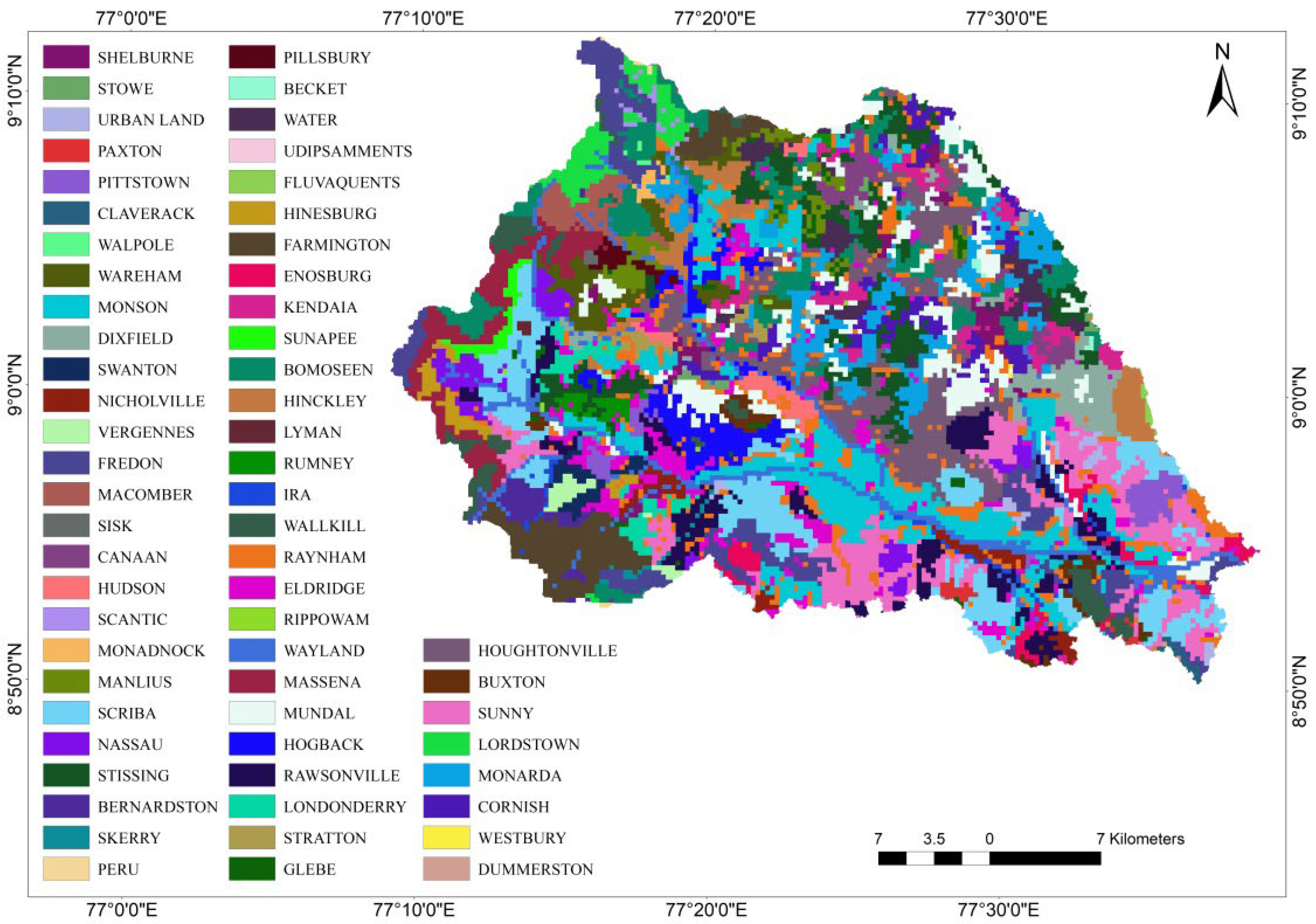

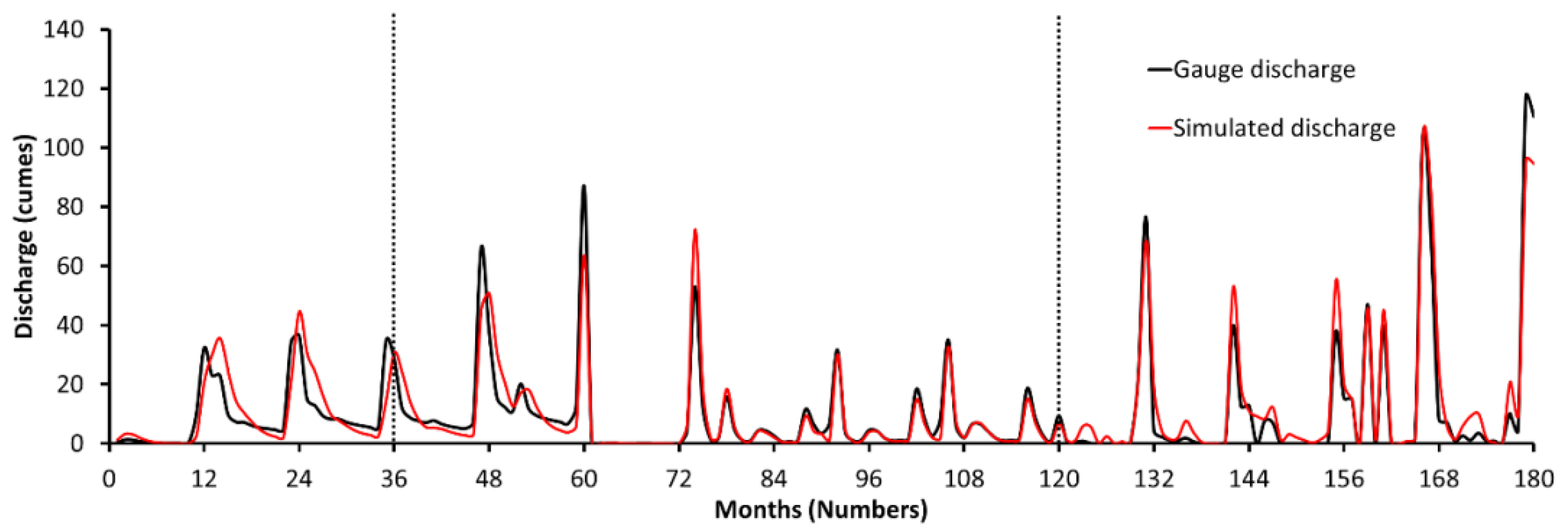

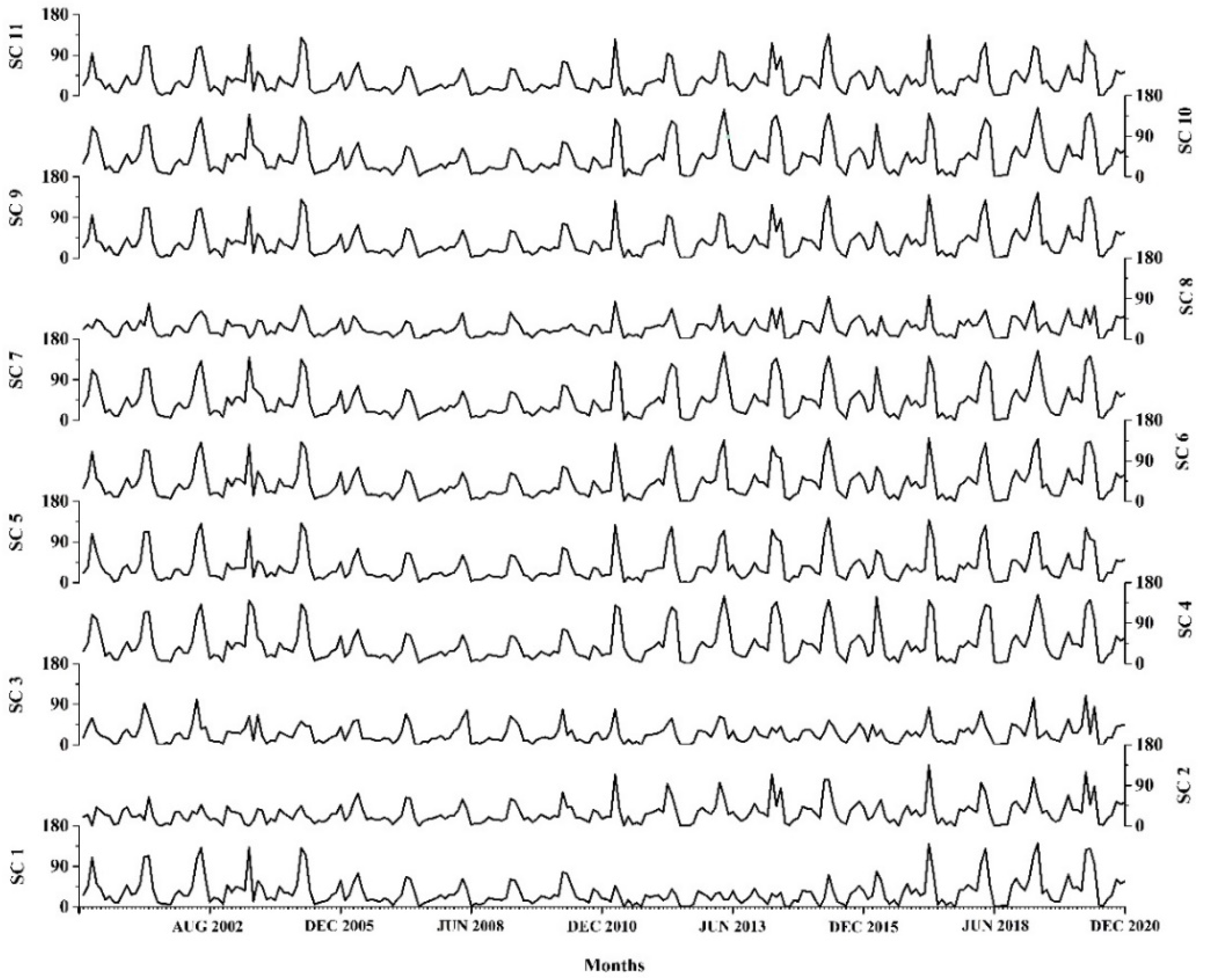
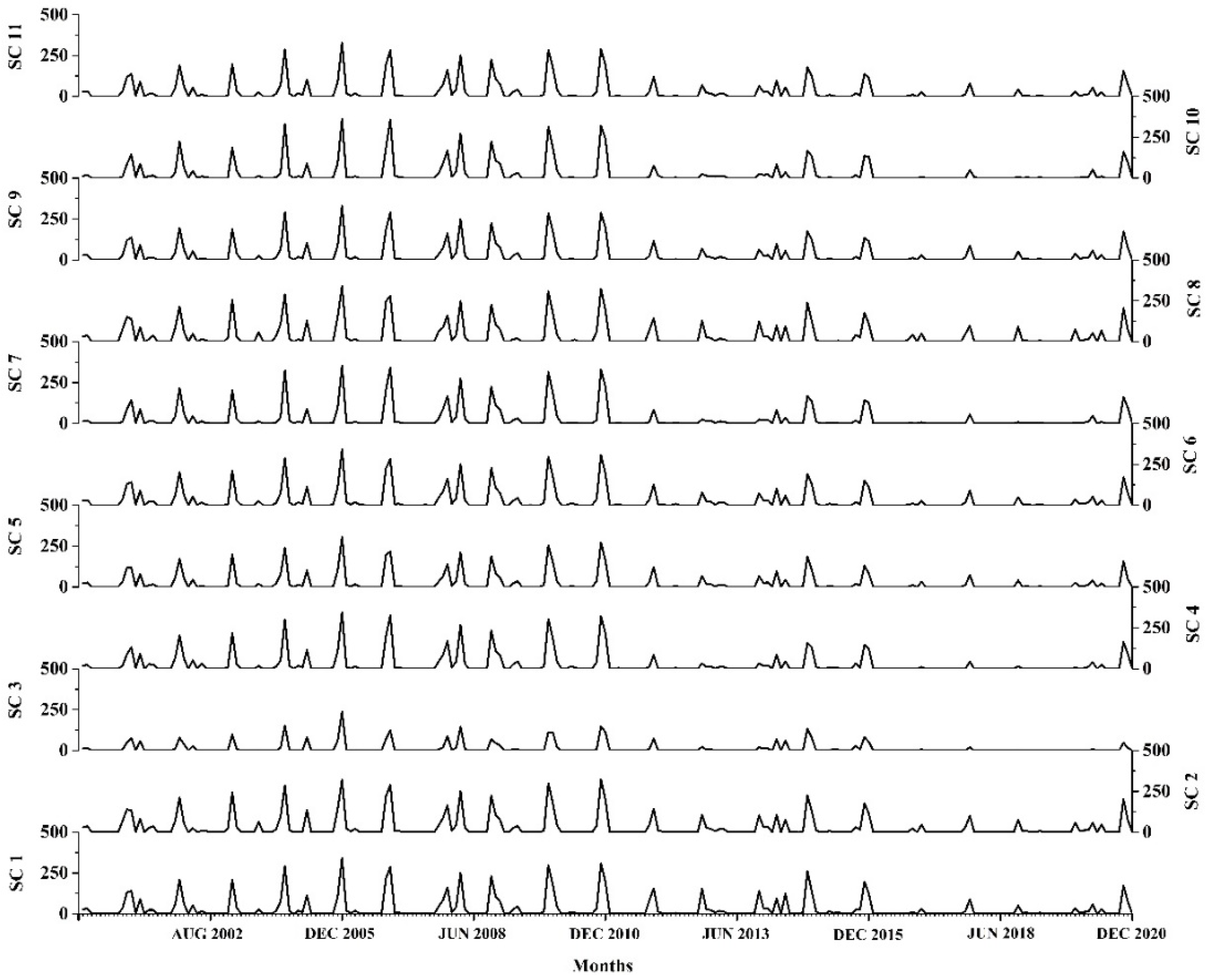
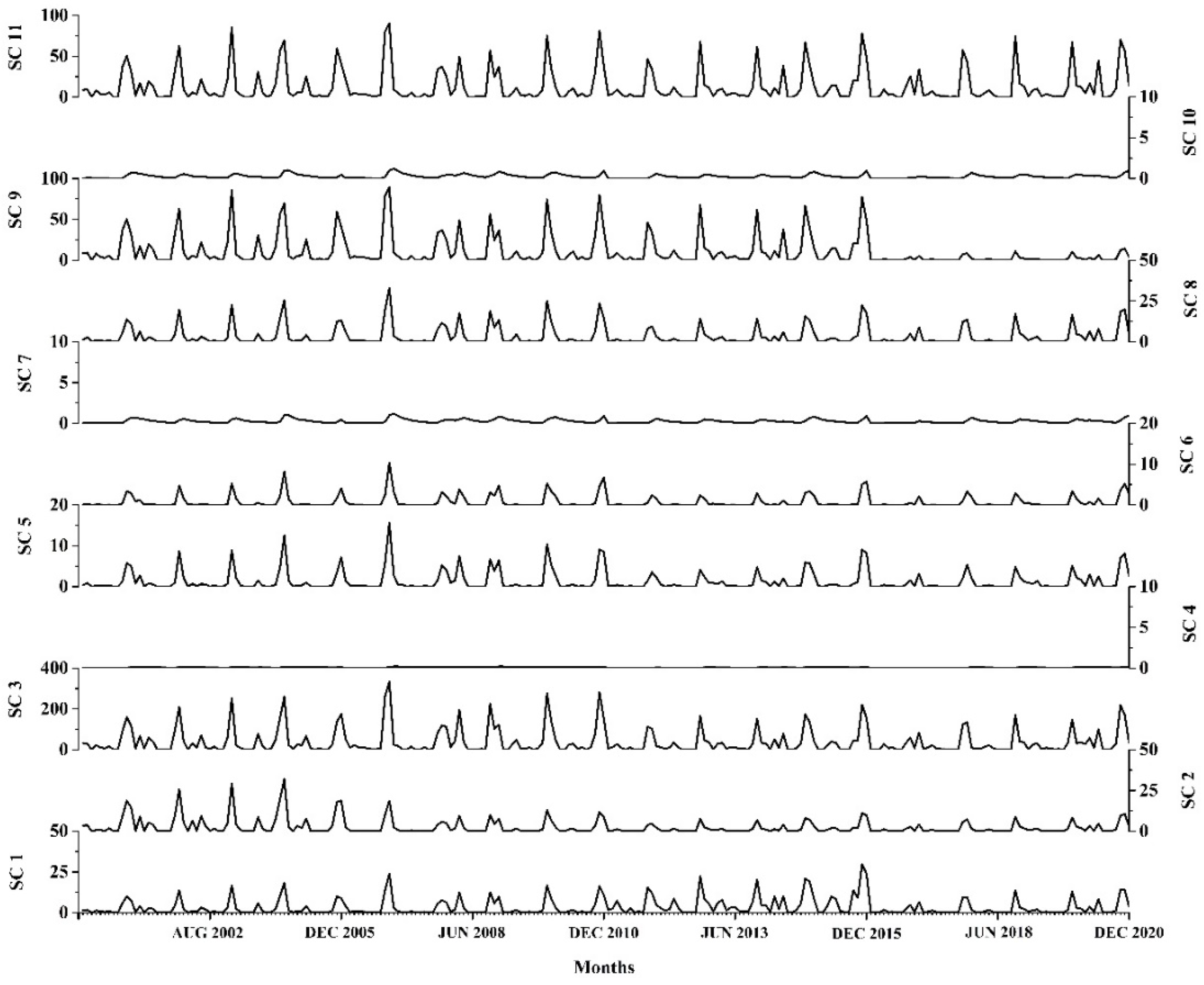
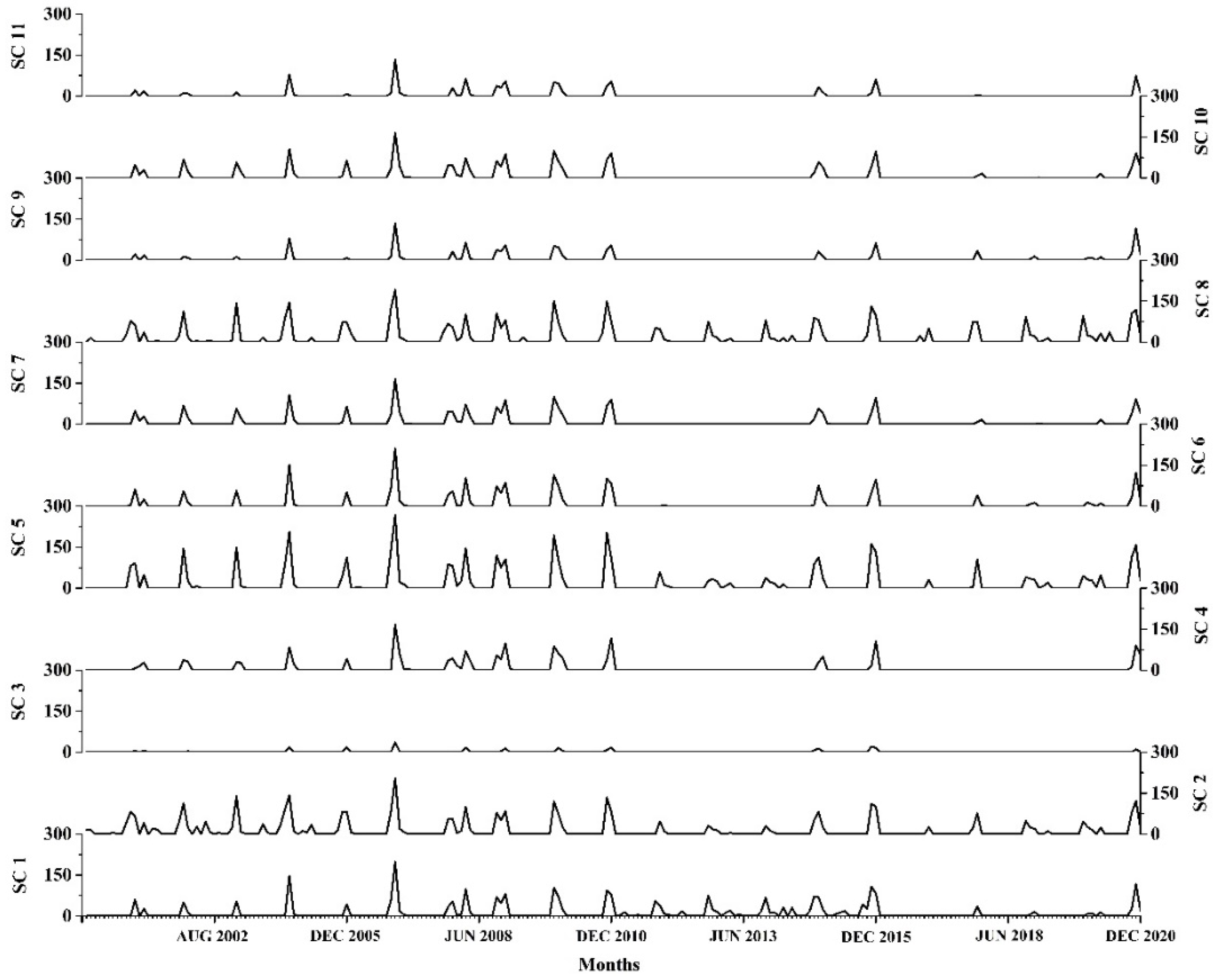

| Parameters | Description | Process | Fitted Value | p-Value | t-Stat | Rank |
|---|---|---|---|---|---|---|
| CN2 | Initial SCS-CN moisture condition II | Runoff | −0.095 | 0.00 | 4.19 | 1 |
| GW_DELAY | Groundwater delay time (days) | Groundwater | 0.115 | 0.00 | −5.96 | 2 |
| ALPHA_BNK | Baseflow alpha factor for bank storage (1/days) | Groundwater | 223.600 | 0.00 | −4.70 | 3 |
| SOL_AWC | Available water capacity of the first soil layer (mm H2O soil) | SW | 2.625 | 0.00 | 5.33 | 4 |
| OV_N | Manning’s n value for overland flow | Runoff | 0.302 | 0.02 | −2.36 | 5 |
| SOL_K | Saturated hydraulic conductivity (mm/h) | SW | 2.555 | 0.12 | −1.59 | 6 |
| ALPHA_BF | Baseflow alpha factor (1/days) | Groundwater | 3.240 | 0.17 | −1.38 | 7 |
| CH_K2 | Effective hydraulic conductivity in main channel alluvium (mm/h) | River Channel | −0.345 | 0.20 | 1.31 | 8 |
| EPCO | Plant uptake compensation factor | AE | −9.720 | 0.21 | 1.26 | 9 |
| ESCO | Soil evaporation compensation factor | AE | 0.498 | 0.22 | 1.25 | 10 |
| GW_REVAP | Groundwater revap coefficient | Groundwater | 42.525 | 0.32 | −1.00 | 11 |
| SLSUBBSN | Average slope length (m) | Topography | −3.765 | 0.34 | −0.96 | 12 |
| GWQMN | Threshold depth of water in the shallow aquifer required for return flow to occur (mm H2O) | Groundwater | 0.310 | 0.34 | −0.97 | 13 |
| SURLAG | Surface runoff lag co efficient | Runoff | 0.248 | 0.43 | −0.79 | 14 |
| REVAPMN | Threshold depth of water in the shallow aquifer for revap to occur | Groundwater | 0.046 | 0.57 | −0.57 | 15 |
| CH_N2 | Manning’s n value for the main channel | River Channel | 0.081 | 0.61 | 0.52 | 16 |
| SOL_BD | Moist bulk density (Mg/m3) | SW | 0.161 | 0.85 | 0.19 | 17 |
| HRU_SLP | Average slope steepness (m) | Topography | 24.880 | 0.88 | −0.15 | 18 |
| Performance Indexes | Pre-Calibration | Post-Calibration | Validation |
|---|---|---|---|
| P-factor | 0.90 | 0.98 | 0.60 |
| R-factor | 2.29 | 1.14 | 0.77 |
| Coefficient of determination (R2) | 0.75 | 0.94 | 0.81 |
| Nash-Sutcliffe (NS) | 0.75 | 0.89 | 0.76 |
| Percent bias (PBIAS)% | −1.70 | 2.70 | 1.60 |
| Kling –Gupta efficiency | 0.84 | 0.82 | 0.66 |
| Root Mean Square Error (RMSE) mm | 0.50 | 0.33 | 0.49 |
| Modified Nash-Sutcliffe | 0.47 | 0.78 | 0.71 |
Disclaimer/Publisher’s Note: The statements, opinions and data contained in all publications are solely those of the individual author(s) and contributor(s) and not of MDPI and/or the editor(s). MDPI and/or the editor(s) disclaim responsibility for any injury to people or property resulting from any ideas, methods, instructions or products referred to in the content. |
© 2023 by the authors. Licensee MDPI, Basel, Switzerland. This article is an open access article distributed under the terms and conditions of the Creative Commons Attribution (CC BY) license (https://creativecommons.org/licenses/by/4.0/).
Share and Cite
Pandi, D.; Kothandaraman, S.; Kuppusamy, M. Simulation of Water Balance Components Using SWAT Model at Sub Catchment Level. Sustainability 2023, 15, 1438. https://doi.org/10.3390/su15021438
Pandi D, Kothandaraman S, Kuppusamy M. Simulation of Water Balance Components Using SWAT Model at Sub Catchment Level. Sustainability. 2023; 15(2):1438. https://doi.org/10.3390/su15021438
Chicago/Turabian StylePandi, Dinagarapandi, Saravanan Kothandaraman, and Mohan Kuppusamy. 2023. "Simulation of Water Balance Components Using SWAT Model at Sub Catchment Level" Sustainability 15, no. 2: 1438. https://doi.org/10.3390/su15021438
APA StylePandi, D., Kothandaraman, S., & Kuppusamy, M. (2023). Simulation of Water Balance Components Using SWAT Model at Sub Catchment Level. Sustainability, 15(2), 1438. https://doi.org/10.3390/su15021438









